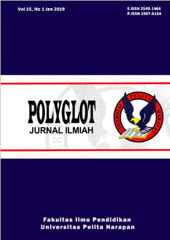KONSELING KELOMPOK DENGAN PENDEKATAN EKSISTENSIAL-HUMANISTIK UNTUK MELATIH PENYESUAIAN DIRI MELALUI RANDAI DARI MINANGKABAU [GROUP COUNSELING USING AN EXISTENTIAL-HUMANISTIC APPROACH TO DEVELOP SELF-ADJUSTMENT COMBINED WITH THE EXPRESSIVE ARTS TECHNIQUES OF RANDAI OF MINANGKABAU]
DOI:
https://doi.org/10.19166/pji.v15i1.1071Schlagworte:
expressive arts, group counseling, existential-humanistic approach, self-adjustment, Randai, Minangkabau, konseling kelompok, pendekatan eksistensial-humanistik, penyesuaian diriAbstract
Group counseling is a group therapeutic activity to help the counselee identify problems, find alternatives using problem- solving and decision-making, and then act. The existential-humanistic approach in group counseling aims at influencing the counselee to focus on human nature, including the ability to be self-aware, self-determined, and responsible. For clients that need help with self-adjustment, counseling can be combined with the expressive arts techniques of Randai (a folk theatre tradition of the Minangkabau ethinic group in West Sumatra). The application of Randai can be done at the working stage. Using Randai, clients can be trained to be cautious, compact, cooperative, diligent, and optimistic.
ABSTRAK: Konseling kelompok merupakan kegiatan terapeutik berkelompok guna membantu konseli mengidentifikasi, menemukan alternatif pemecahan masalah dan pengambilan keputusan dan mewujudkannya. Pendekatan eksistensial-humanistik dalam konseling kelompok bertujuan mempengaruhi konseli berfokus pada sifat manusia mencakup kesanggupan untuk menyadari diri, bebas menentukan nasib sendiri, dan bertanggungjawab. Dalam praktik konseling dikolaborasikan dengan kegiatan randai dari Minangkabau sebagai upaya melatih penyesuaian diri. Penerapan randai dilaksanakan pada tahap kerja (working stage). Dalam randai, klien dilatih bersikap hati-hati, kompak, kerjasama, tekun dan optimis.
Literaturhinweise
Achmad, A. K. (1980). Ungkapan beberapa kesenian: teater, wayang, dan tari. Jakarta, Indonesia: Direktorat Kesenian, Proyek Pengembangan Kesenian.
Ellis, A. (1955). New approaches to psychotherapy techniques. Journal of Clinical Psychology, 11(3), 207-260. https://doi.org/10.1002/1097-4679(195507)11:3<207::aid-jclp2270110302>3.0.co;2-1
Esten, M. (1983). Indonesia dan Minangkabau: Eksistensi dalam perubahan. Horison, 18(2).
Harun, C. (1992). Kesenian randai di Minangkabau. Jakarta, Indonesia: Proyek Pembinaan Media Kebudayaan.
Hurlock, B. E. (1999). Perkembangan anak jilid 2. Jakarta, Indonesia: Erlangga.
Kayam, U. (1984). Semangat Indonesia: Suatu perjalanan budaya. Jakarta, Indonesia: PT. Gramedia.
Kemendikbud (2016). Panduan operasional penyelenggaraan bimbingan dan konseling Sekolah Menengah Pertama (SMP). Jakarta, Indonesia.
Maslow, A. H. (1968). Toward a psychology of being. New York, NY: Van Nostrand Reinhold.
Paisley, P. O., & Young, R. E. (2007). What a school administrator needs to know about expressive arts and play media in school counseling. In C. Dykeman (Ed.), Maximizing school guidance program effectiveness: A guide for school administrators & program directors (pp. 105-109). CAPS Press.
Poerwadarminta. (1983). Kamus umum bahasa Indonesia. Jakarta, Indonesia: Balai Pustaka.
Prayitno, P. (2004). Layanan bimbingan kelompok dan konseling kelompok. Padang, Indonesia: Universitas Negeri Padang.
Winkel, W. S. (1987). Bimbingan dan praktek konseling dan psikoterapi. Jakarta, Indonesia: PT. Gramedia.
Downloads
Zusätzliche Dateien
Veröffentlicht
Ausgabe
Rubrik
Lizenz
Authors who publish with this journal agree to the following terms:
1) Authors retain copyright and grant the journal right of first publication with the work simultaneously licensed under a Creative Commons Attribution License (CC-BY-SA 4.0) that allows others to share the work with an acknowledgement of the work's authorship and initial publication in this journal.
2) Authors are able to enter into separate, additional contractual arrangements for the non-exclusive distribution of the journal's published version of the work (e.g., post it to an institutional repository or publish it in a book), with an acknowledgement of its initial publication in this journal.
3) Authors are permitted and encouraged to post their work online (e.g., in institutional repositories or on their website). The final published PDF should be used and bibliographic details that credit the publication in this journal should be included.





